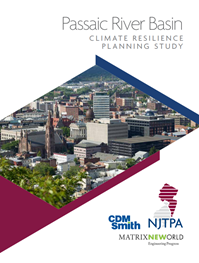July 2019
Posted: 7/26/2019 2:01:17 PM
 The chronic flooding in the Passaic River Basin, home to some 2.5 million people, is likely to get worse as a result of climate change, raising serious threats to homes, businesses and the area’s heavily used transportation system. That is a key conclusion of a major study sponsored by the NJTPA which sought to assess the threats and find solutions.
The chronic flooding in the Passaic River Basin, home to some 2.5 million people, is likely to get worse as a result of climate change, raising serious threats to homes, businesses and the area’s heavily used transportation system. That is a key conclusion of a major study sponsored by the NJTPA which sought to assess the threats and find solutions.
Encompassing parts of eight New Jersey counties and extending into New York State, the basin is centered on the Passaic River and its tributaries. Since 1900, at least 26 lives have been lost in floods in the basin, with property losses of $5.5 billion. An April 2007 flood resulted in over 5,000 people being evacuated and major storms in recent years have also taken their toll.
The Passaic River Basin Climate Resilience Planning Study projected the occurrence of extreme heat events and extreme precipitation events for two horizon years: 2045 and 2080. The projections found that areas adjacent to the region’s waterways — already prone to flooding — could face more frequent and more severe storms. In 2045, the annual chance of a storm producing 9.1 inches of precipitation over 4 days is approximately twice as likely as today. This, coupled with continued development in the areas, the report says, “increases the likelihood of future property losses, threatens the economic stability of communities, and puts public health and safety at risk.”
At least 10 percent of the 3,245 transportation assets evaluated in the basin were determined to be “highly vulnerable to existing and future heat and/or floods events.” This includes bridges, culverts, rail, roads including bus routes, and transit rolling stock.
In consultation with a technical advisory committee, which included representatives of the eight area counties and state agencies, 71 adaptation strategies were developed to safeguard infrastructure and address the threats. Among the recommendations was to, “Use the vulnerability assessment findings in current and future planning and design studies to inform the siting of new infrastructure and updates and improvements to existing infrastructure.” Further data collection, modeling and regionwide coordination were also called for.
The final report and several appendices are available for download at the NJTPA website.
Posted: 7/17/2019 9:41:53 AM
New Jersey has made great progress in realizing racial diversity in its suburbs in the last two decades, but dozens of communities face the threat of resegregation due to ongoing discrimination and disinvestment, according to Myron Orfield, Director of the Institute on Metropolitan Opportunity at the University of Minnesota Law School. Orfield highlighted these trends in a presentation to the NJTPA Board on July 8.
His presentation, “The Challenges and Opportunities of Growing Racial Diversity in the Suburbs of Northern New Jersey,” was part of NJTPA’s ongoing series of speakers, forums and events in preparation for updating its long range transportation plan from 2045 to 2050.
Communities that are racially diverse (where minorities compose 20 to 60 percent of the population) have better school achievement, more upward mobility and more positive attitudes about racial differences, Orfield said. Nationwide, such communities are growing. By 2040, he said, the nation will be fully multi-racial, with no race having a majority.
In New Jersey, diversity has grown dramatically. In 2000, 41 percent of the state’s population lived in predominately white suburbs. That number dropped to 17 percent in 2017.
Despite the progress, he said, suburban areas tend not to stay integrated for long. New Jersey leads the nation in the rate at which suburban communities are losing their diversity, as whites shift to “whiter enclaves” In other suburbs or center cities.
The reason he says is “relentless driving discrimination,” in which some real estate brokers steer buyers to areas based on race, some mortgage lenders hamper minority homeownership and zoning policies undermine affordable housing. The result are communities that lose their “tax capacity” and suffer declining schools along with their ability to attract and retain residents and businesses.
Unless the situation is addressed, said Orfield, once thriving suburbs will become “disinvested places” that developers and investors will “write off” for future projects.
One of the key solutions is affordable housing. New Jersey’s Mt. Laurel court decision, which required each town to build an equitable share of affordable housing, was not fully implemented in the state. But it has become the model, he said, for at least 10 other states, such as Minnesota, Washington and Oregon, that are stabilizing diversity through affordable housing.
Creating networks of magnet schools in and around cities such as Louisville based on a metropolitan-wide approach to governance, he said, has also helped counteract resegregation.
He predicted that emerging court challenges to school segregation in New Jersey will soon lead to other opportunities for the state to foster diversity. The state, he said, must rise to the challenge. “It’s a hard thing to work on but important thing in a multi-racial, metropolitan nation.”
View the video of his presentation above. Presentation slides can be downloaded here.